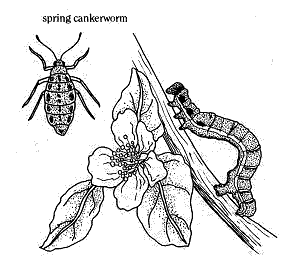Also known as inchworms, these are striped brown and green worms about 1 inch long. You may have bumped into them at times when walking under a tree. They often drop from branches on fine silken threads. Some species attempt to mimic a twig by remaining stiff and motionless when disturbed. The adult males are grayish moths; adult females are wingless moths.
 |
The fall cankerworm lays eggs in late fall, after frost, in compact masses on tree trunks or branches. These eggs are shaped like flowerpots and are brown or gray in color.
Spring cankerworm eggs are brownish purple and can be found in clusters beneath the bark of trees in very early spring. Both fall and spring cankerworms can be found throughout most of North America.
 |
Vulnerable Plants
Apple and cherry trees are often targets of the cankerworm.
Emergence Time
Larvae of the fall cankerworm emerge in the spring from the eggs laid the previous fall; then they begin to feed on new foliage. The spring cankerworm lays its eggs anytime between February and the end of April. These will hatch within a month's time, and the larvae will begin to eat.
Symptoms of Cankerworm
Cankerworms feed heavily on the foliage of plants and will skeletonize the leaves. Infested trees weaken each year. Not much fruit will mature. Cankerworms can defoliate a tree and kill it.

